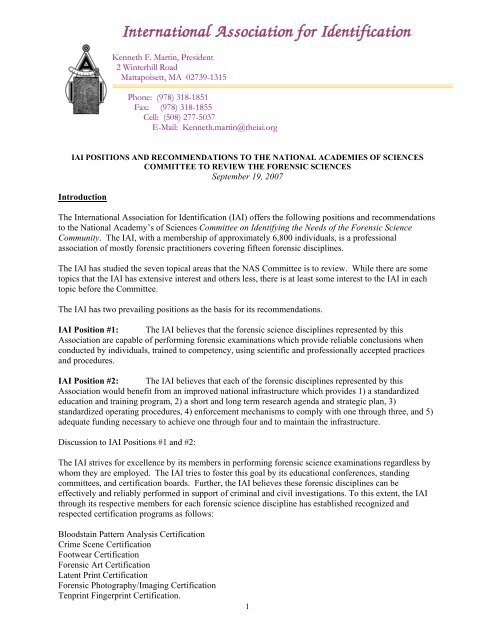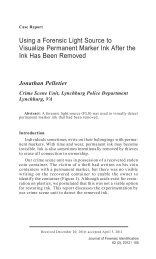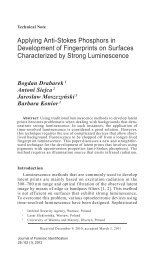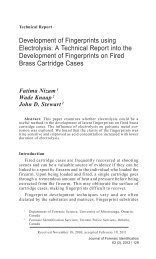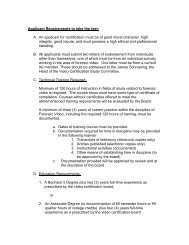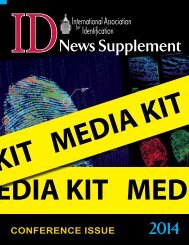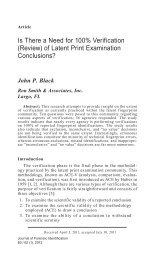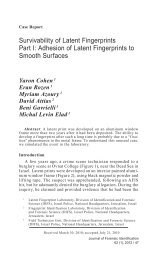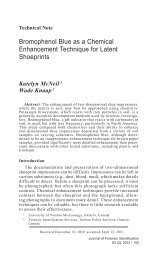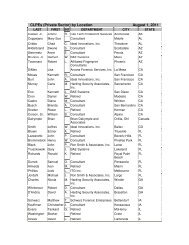Positions and Recommendations to the National Academy of ...
Positions and Recommendations to the National Academy of ...
Positions and Recommendations to the National Academy of ...
Create successful ePaper yourself
Turn your PDF publications into a flip-book with our unique Google optimized e-Paper software.
International Association for Identification<br />
Kenneth F. Martin, President<br />
2 Winterhill Road<br />
Mattapoisett, MA 02739-1315<br />
Phone: (978) 318-1851<br />
Fax: (978) 318-1855<br />
Cell: (508) 277-5037<br />
E-Mail: Kenneth.martin@<strong>the</strong>iai.org<br />
IAI POSITIONS AND RECOMMENDATIONS TO THE NATIONAL ACADEMIES OF SCIENCES<br />
COMMITTEE TO REVIEW THE FORENSIC SCIENCES<br />
September 19, 2007<br />
Introduction<br />
The International Association for Identification (IAI) <strong>of</strong>fers <strong>the</strong> following positions <strong>and</strong> recommendations<br />
<strong>to</strong> <strong>the</strong> <strong>National</strong> <strong>Academy</strong>’s <strong>of</strong> Sciences Committee on Identifying <strong>the</strong> Needs <strong>of</strong> <strong>the</strong> Forensic Science<br />
Community. The IAI, with a membership <strong>of</strong> approximately 6,800 individuals, is a pr<strong>of</strong>essional<br />
association <strong>of</strong> mostly forensic practitioners covering fifteen forensic disciplines.<br />
The IAI has studied <strong>the</strong> seven <strong>to</strong>pical areas that <strong>the</strong> NAS Committee is <strong>to</strong> review. While <strong>the</strong>re are some<br />
<strong>to</strong>pics that <strong>the</strong> IAI has extensive interest <strong>and</strong> o<strong>the</strong>rs less, <strong>the</strong>re is at least some interest <strong>to</strong> <strong>the</strong> IAI in each<br />
<strong>to</strong>pic before <strong>the</strong> Committee.<br />
The IAI has two prevailing positions as <strong>the</strong> basis for its recommendations.<br />
IAI Position #1: The IAI believes that <strong>the</strong> forensic science disciplines represented by this<br />
Association are capable <strong>of</strong> performing forensic examinations which provide reliable conclusions when<br />
conducted by individuals, trained <strong>to</strong> competency, using scientific <strong>and</strong> pr<strong>of</strong>essionally accepted practices<br />
<strong>and</strong> procedures.<br />
IAI Position #2: The IAI believes that each <strong>of</strong> <strong>the</strong> forensic disciplines represented by this<br />
Association would benefit from an improved national infrastructure which provides 1) a st<strong>and</strong>ardized<br />
education <strong>and</strong> training program, 2) a short <strong>and</strong> long term research agenda <strong>and</strong> strategic plan, 3)<br />
st<strong>and</strong>ardized operating procedures, 4) enforcement mechanisms <strong>to</strong> comply with one through three, <strong>and</strong> 5)<br />
adequate funding necessary <strong>to</strong> achieve one through four <strong>and</strong> <strong>to</strong> maintain <strong>the</strong> infrastructure.<br />
Discussion <strong>to</strong> IAI <strong>Positions</strong> #1 <strong>and</strong> #2:<br />
The IAI strives for excellence by its members in performing forensic science examinations regardless by<br />
whom <strong>the</strong>y are employed. The IAI tries <strong>to</strong> foster this goal by its educational conferences, st<strong>and</strong>ing<br />
committees, <strong>and</strong> certification boards. Fur<strong>the</strong>r, <strong>the</strong> IAI believes <strong>the</strong>se forensic disciplines can be<br />
effectively <strong>and</strong> reliably performed in support <strong>of</strong> criminal <strong>and</strong> civil investigations. To this extent, <strong>the</strong> IAI<br />
through its respective members for each forensic science discipline has established recognized <strong>and</strong><br />
respected certification programs as follows:<br />
Bloodstain Pattern Analysis Certification<br />
Crime Scene Certification<br />
Footwear Certification<br />
Forensic Art Certification<br />
Latent Print Certification<br />
Forensic Pho<strong>to</strong>graphy/Imaging Certification<br />
Tenprint Fingerprint Certification.<br />
1
If, for any reason, <strong>the</strong> IAI became aware <strong>of</strong> any <strong>of</strong> <strong>the</strong> forensic science disciplines represented within this<br />
Association as being unreliable or lacking sufficient basis for conducting forensic examinations or<br />
reaching stated conclusions, <strong>the</strong> IAI would take immediate action. Ei<strong>the</strong>r, <strong>the</strong> discipline would be<br />
removed from recognition by <strong>the</strong> IAI or a new or revised position regarding <strong>the</strong> reliability <strong>of</strong> that<br />
discipline would be established.<br />
The IAI maintains <strong>the</strong> position that reliable conclusions are capable <strong>of</strong> being made. While <strong>the</strong> IAI has <strong>the</strong><br />
subject matter experts (SME), one should not construe that <strong>the</strong>y have <strong>the</strong> financial <strong>and</strong>/or administrative<br />
means, or <strong>the</strong> authority <strong>to</strong> review actual investigative case work conducted on a daily basis, by a member,<br />
a law enforcement agency, or a private labora<strong>to</strong>ry <strong>to</strong> assess accuracy. Ra<strong>the</strong>r, it is through a consensus <strong>of</strong><br />
IAI member practitioners <strong>and</strong> <strong>the</strong> certification programs that when accepted procedures <strong>and</strong> practices are<br />
stringently followed during <strong>the</strong> forensic science examination, <strong>the</strong> examiner is provided <strong>the</strong> basis <strong>to</strong> reach<br />
reliable conclusions.<br />
The IAI recognizes <strong>the</strong> Scientific Working Groups (SWG’s), sponsored by <strong>the</strong> FBI, as an integral part <strong>of</strong><br />
maintaining many <strong>of</strong> <strong>the</strong> forensic science disciplines. Many IAI members are also members <strong>of</strong> <strong>the</strong>ir<br />
respective SWG. For example, <strong>the</strong> Scientific Working Group on Friction Ridge Analysis, Study <strong>and</strong><br />
Technology (SWGFAST) currently has 39 members, <strong>of</strong> which 37 are IAI members. SWGFAST<br />
primarily addresses forensic latent print examinations but has recently added tenprint examinations based<br />
on a request from <strong>the</strong> IAI. Several years ago, <strong>the</strong> IAI endorsed <strong>and</strong> recognized <strong>the</strong> SWGFAST Guidelines<br />
<strong>and</strong> St<strong>and</strong>ards <strong>and</strong> has not altered that position <strong>to</strong>date.<br />
Similarly, this scenario <strong>of</strong> close association through shared membership with <strong>the</strong> SWG’s is repeated for<br />
several o<strong>the</strong>r forensic science disciplines within <strong>the</strong> IAI as well, such as SWGTREAD, SWGIT, <strong>and</strong><br />
SWGSTAIN. We would be remiss if we did not share with <strong>the</strong> NAS Committee that for several reasons<br />
not all law enforcement agencies, some <strong>of</strong> which employ IAI members, do not endorse or adhere <strong>to</strong> SWG<br />
Guidelines <strong>and</strong> St<strong>and</strong>ards, nor <strong>to</strong> IAI guidelines. Nei<strong>the</strong>r <strong>the</strong> IAI nor <strong>the</strong> SWG's (with <strong>the</strong> exception <strong>of</strong><br />
SWGDAM - for forensic DNA) has any enforcement authority. Regardless, <strong>the</strong> IAI utilizes <strong>the</strong> SWG<br />
Guidelines <strong>and</strong> St<strong>and</strong>ards in fur<strong>the</strong>ring our desire for st<strong>and</strong>ards <strong>and</strong> <strong>to</strong> provide generally accepted<br />
practices in<strong>to</strong> <strong>the</strong> IAI certification programs. With <strong>the</strong>se as <strong>the</strong> only guidelines <strong>and</strong> st<strong>and</strong>ards in existence<br />
<strong>and</strong> a lack by some agencies <strong>to</strong> follow <strong>the</strong>m, <strong>the</strong>re needs <strong>to</strong> be a more formalized st<strong>and</strong>ard setting body<br />
similar <strong>to</strong> <strong>the</strong> DAB (DNA Advisory Board) <strong>and</strong> with similar st<strong>and</strong>ard setting authority.<br />
The IAI believes that his<strong>to</strong>rically <strong>the</strong> forensic sciences have addressed <strong>the</strong> needs <strong>of</strong> <strong>the</strong> public <strong>and</strong> judicial<br />
communities, performed well <strong>and</strong>, as any good science, continuously seek <strong>to</strong> improve. This has been a<br />
constant struggle due <strong>to</strong> <strong>the</strong> lack <strong>of</strong> a well-defined <strong>and</strong> funded forensic science infrastructure. The<br />
forensic sciences strive <strong>to</strong> do <strong>the</strong> best <strong>the</strong>y can given <strong>the</strong> environment. The recent (past 10 years)<br />
emphasis on forensic DNA has brought forward a business model that has proven effective in getting <strong>the</strong><br />
DNA discipline <strong>to</strong> a well respected <strong>and</strong> scientifically sound forensic science. It is <strong>the</strong> business model, not<br />
<strong>the</strong> science based model, which needs <strong>to</strong> be fostered for <strong>the</strong> remaining forensic sciences. This distinction<br />
is <strong>the</strong> basis for <strong>the</strong> IAI’s Position Statement #2. The DNA business model brought congressional<br />
legislation, enforcement authority, training requirements, m<strong>and</strong>ated st<strong>and</strong>ard operating procedures,<br />
accreditation <strong>and</strong> certification programs, <strong>and</strong> <strong>the</strong> funding <strong>to</strong> ensure its success. Over <strong>the</strong> years, <strong>the</strong><br />
congressional funding (Federal <strong>and</strong> State) for DNA has exceeded all o<strong>the</strong>r forensic sciences combined, as<br />
reported by <strong>the</strong> news <strong>and</strong> communication media.<br />
The IAI recognizes that <strong>the</strong> forensic sciences should not be stagnant nor rest on past laurels, <strong>and</strong> that <strong>the</strong><br />
key <strong>to</strong> moving forward <strong>and</strong> improvement is through education <strong>and</strong> research. The IAI believes that<br />
research is best performed as a cooperative initiative with universities, private <strong>and</strong> public research<br />
labora<strong>to</strong>ries, product manufacturers, <strong>and</strong> forensic science practitioners. Unfortunately, <strong>the</strong>re are<br />
numerous research initiatives being funded <strong>and</strong> pursued with no over-arching strategic plan. At best, <strong>the</strong><br />
current approach provides little benefit at great cost in comparison <strong>to</strong> a well thought-out <strong>and</strong> managed<br />
program on a national/international basis. There is a need for <strong>the</strong> development <strong>of</strong> a national/international<br />
forensic science research strategic plan which coordinates key entities, priorities, sequence <strong>of</strong> research,<br />
data collection <strong>and</strong> availability, <strong>and</strong> provides mechanisms for continuous funding. Specific research<br />
2
projects, which are discipline specific, while desirable by <strong>the</strong> IAI, are not <strong>the</strong> primary focus. Ra<strong>the</strong>r, <strong>the</strong><br />
IAI desires that <strong>the</strong> business infrastructure <strong>to</strong> achieve <strong>the</strong>se objectives be created <strong>and</strong> funded. The actual<br />
research <strong>to</strong> be performed would be determined by those serving on a forensic science discipline specific<br />
strategic planning board.<br />
The IAI believes <strong>the</strong> forensic science disciplines are currently questioned <strong>and</strong> challenged as <strong>to</strong> <strong>the</strong><br />
scientific basis from two categories <strong>of</strong> individuals. The first category includes competent individuals who<br />
are well informed, trained <strong>and</strong> have practical experience, whereas, <strong>the</strong> second category <strong>of</strong> individuals lack<br />
some or all <strong>of</strong> <strong>the</strong>se qualities <strong>and</strong> generally have a self-serving agenda. Legitimate challenges <strong>to</strong> <strong>the</strong><br />
scientific validity <strong>of</strong> <strong>the</strong> forensic sciences are encouraged <strong>and</strong> welcomed <strong>and</strong> are welcomed <strong>and</strong> should be<br />
addressed in a scientific or educational setting ra<strong>the</strong>r than debated in <strong>the</strong> courtroom. Therefore, <strong>the</strong> IAI<br />
supports <strong>the</strong> creation <strong>of</strong> a business infrastructure which encourages a greater involvement <strong>of</strong> those outside<br />
<strong>the</strong> forensic science community <strong>the</strong>reby providing <strong>the</strong> mechanism for bringing <strong>the</strong>ir concerns forward <strong>and</strong><br />
thwarting <strong>the</strong> perceived need by <strong>the</strong>se individuals <strong>to</strong> bring <strong>the</strong>ir concerns <strong>and</strong> criticisms in<strong>to</strong> <strong>the</strong><br />
courtroom, as <strong>the</strong>ir only course <strong>of</strong> recognition. The creation <strong>of</strong> <strong>the</strong> proposed infrastructure would provide<br />
means <strong>to</strong> identify <strong>and</strong> address legitimate concerns while discrediting those criticisms that are not valid.<br />
This approach would address valid concerns prior <strong>to</strong> <strong>the</strong> judicial process <strong>and</strong> give <strong>the</strong> court information<br />
for its gatekeeper role <strong>and</strong> rulings, as well as result in timesavings <strong>to</strong> <strong>the</strong> court.<br />
The IAI holds an annual educational conference <strong>and</strong> many <strong>of</strong> <strong>the</strong> local Divisions <strong>of</strong> <strong>the</strong> IAI also conduct<br />
educational conferences throughout <strong>the</strong> year, as well as list training opportunities given by recognized<br />
providers. The goal is <strong>to</strong> provide training <strong>and</strong> <strong>to</strong> share information relative <strong>to</strong> <strong>the</strong> member’s needs <strong>and</strong> <strong>the</strong><br />
forensic science disciplines within <strong>the</strong> association. For many years it has been noted by <strong>the</strong> IAI that<br />
forensic science lacks training st<strong>and</strong>ards. The IAI has developed training guidelines for several <strong>of</strong> <strong>the</strong><br />
forensic science disciplines <strong>and</strong>, as time requires, has updated <strong>the</strong>m as well. IAI recognizes that <strong>the</strong><br />
SWG's have also developed training guidelines. Regardless, some agencies perceive <strong>the</strong>se guidelines as<br />
non-m<strong>and</strong>a<strong>to</strong>ry <strong>and</strong> as a result many practitioners do not receive <strong>the</strong> full extent <strong>of</strong> training recommended.<br />
The obstacle <strong>to</strong> be overcome is that <strong>of</strong> an enforceable national st<strong>and</strong>ard for education <strong>and</strong> training specific<br />
<strong>to</strong> each forensic science discipline. This is fur<strong>the</strong>r justification for <strong>the</strong> need <strong>of</strong> a forensic science<br />
infrastructure that supports st<strong>and</strong>ard forensic science training.<br />
The exact same scenario plays out when discussing <strong>the</strong> need for st<strong>and</strong>ard operating procedures. While<br />
guidelines exist, <strong>the</strong> ability <strong>to</strong> enforce <strong>the</strong>m is lacking as well as <strong>the</strong> infrastructure <strong>to</strong> create <strong>and</strong> maintain<br />
guidelines <strong>and</strong> st<strong>and</strong>ards.<br />
A limited exception <strong>to</strong> <strong>the</strong> inability <strong>to</strong> enforce education, training <strong>and</strong> adherence <strong>to</strong> st<strong>and</strong>ard operating<br />
procedures is through an accepted, recognized <strong>and</strong> independent accreditation process. While going<br />
through <strong>the</strong> process <strong>of</strong> becoming accredited an agency must meet certain requirements associated with<br />
education, training <strong>and</strong> st<strong>and</strong>ard operating procedures. But striving for accreditation is a voluntary action,<br />
<strong>and</strong> not a m<strong>and</strong>a<strong>to</strong>ry requirement for providing forensic examination or services.<br />
IAI Recommendation #1: That <strong>the</strong> NAS recommend <strong>to</strong> Congress that a national forensic science<br />
program be established that would create <strong>the</strong> business infrastructure <strong>to</strong> achieve 1) st<strong>and</strong>ard education <strong>and</strong><br />
training programs for each forensic science discipline, 2) a short <strong>and</strong> long term research plan for each<br />
forensic science discipline, 3) st<strong>and</strong>ard operating procedures for each forensic science discipline, 4)<br />
enforcement mechanisms <strong>to</strong> comply with one through three, <strong>and</strong> 5) adequate funding necessary <strong>to</strong> achieve<br />
one through four <strong>and</strong> <strong>to</strong> maintain that infrastructure. Fur<strong>the</strong>r, that <strong>the</strong> business infrastructure initiative<br />
would provide <strong>the</strong> means where a joint effort between <strong>the</strong> general scientific community <strong>and</strong> <strong>the</strong> specific<br />
forensic science community can develop <strong>the</strong> details <strong>of</strong> one through three above.<br />
Fur<strong>the</strong>r, with respect <strong>to</strong> <strong>the</strong> fingerprint discipline that a body such as a Fingerprint Advisory Board (FAB)<br />
be created, perhaps by <strong>the</strong> International Association for Identification (IAI), <strong>to</strong> oversee <strong>the</strong> st<strong>and</strong>ards<br />
process, how <strong>the</strong> st<strong>and</strong>ards are derived, communicated <strong>to</strong> <strong>the</strong> forensic community, <strong>and</strong> enforced. Similar<br />
boards could be created, if needed, for o<strong>the</strong>r pattern evidence disciplines.<br />
3
ACCREDITATION:<br />
IAI Position #3:<br />
The IAI endorses <strong>the</strong> accreditation <strong>of</strong> forensic science operations.<br />
Accreditation by <strong>the</strong> American Society <strong>of</strong> Crime Labora<strong>to</strong>ry Direc<strong>to</strong>rs, Labora<strong>to</strong>ry Accreditation Board<br />
(ASCLD-LAB), Forensic Quality Services (FQS) <strong>and</strong> o<strong>the</strong>rs is widely accepted by many crime<br />
labora<strong>to</strong>ries, but much less so by o<strong>the</strong>r forensic service providers such as identification units, <strong>of</strong>ten found<br />
in law enforcement agencies. In order <strong>to</strong> meet <strong>the</strong> ongoing movement <strong>to</strong>ward accreditation, those<br />
forensic service providers must be made aware <strong>of</strong> <strong>the</strong> benefits <strong>of</strong> accreditation <strong>and</strong> quality systems in<br />
general. Quality managers must be identified <strong>and</strong> appropriate reporting, documentation <strong>and</strong> o<strong>the</strong>r aspects<br />
<strong>of</strong> accreditation be implemented. Accreditation does not come without a cost. Agency administra<strong>to</strong>rs<br />
must be convinced that accreditation is important <strong>and</strong> worthy <strong>of</strong> funding with scarce dollars.<br />
Some would say <strong>the</strong>se types <strong>of</strong> forensic service providers should be completely eliminated <strong>and</strong> all<br />
forensic analyses be conducted in crime labora<strong>to</strong>ries. While perhaps a noble goal, given <strong>the</strong> large amount<br />
<strong>of</strong> forensic work done in identification units, this is not feasible. For example, approximately 66% <strong>of</strong><br />
fingerprint analyses are not conducted in crime labora<strong>to</strong>ries but ra<strong>the</strong>r in identification units.<br />
West Virginia University (WVU) is currently conducting a census <strong>of</strong> non-crime labora<strong>to</strong>ry forensic<br />
service providers <strong>to</strong> get a better idea <strong>of</strong> how many non-crime labora<strong>to</strong>ry entities are doing forensic work,<br />
what kind <strong>of</strong> analyses are conducted, staffing, budgets, etc. The study will mirror <strong>the</strong> BJA document,<br />
Census <strong>of</strong> Public Crime Labora<strong>to</strong>ries <strong>of</strong> which you have a copy. That census will provide a much better<br />
idea <strong>of</strong> this <strong>of</strong>t overlooked segment <strong>of</strong> <strong>the</strong> forensic science system.<br />
The IAI believes that any entity, public or private, performing forensic science examinations, whe<strong>the</strong>r for<br />
criminal or civil purposes, should be accredited by an independent, pr<strong>of</strong>essionally recognized <strong>and</strong><br />
authorized accrediting body. While this will not eradicate errors or preclude unethical behavior <strong>of</strong><br />
practitioners, it will insure that acceptable quality assurance mechanisms are in place <strong>to</strong> reduce <strong>the</strong> risk <strong>of</strong><br />
error <strong>and</strong> <strong>to</strong> more easily detect <strong>and</strong> correct unacceptable practices, as well as unethical behavior. Forensic<br />
science labora<strong>to</strong>ry accreditation is a desired objective by <strong>the</strong> IAI.<br />
IAI Recommendation #2: That <strong>the</strong> NAS recommend <strong>to</strong> Congress <strong>the</strong> establishment <strong>of</strong> a m<strong>and</strong>ate,<br />
with funding, for forensic science labora<strong>to</strong>ry accreditation that must be obtained within a three year<br />
period after passing legislation. (While not a prerequisite, this recommendation is most likely <strong>to</strong> be<br />
achieved if IAI Recommendation #1 is in place.)<br />
That an effort be made <strong>to</strong> fur<strong>the</strong>r publicize <strong>the</strong> importance <strong>of</strong> accreditation <strong>to</strong> forensic service providers <strong>to</strong><br />
raise <strong>the</strong>ir level <strong>of</strong> underst<strong>and</strong>ing <strong>of</strong> <strong>the</strong> importance <strong>of</strong> <strong>the</strong>se quality systems.<br />
CERTIFICATION<br />
IAI Position #4:<br />
The IAI endorses certification <strong>of</strong> forensic science practitioners.<br />
A natural progression from <strong>the</strong> quality systems <strong>of</strong> <strong>the</strong> organization (accreditation) is <strong>the</strong> competency <strong>of</strong><br />
<strong>the</strong> individual, or certification. Certification in forensic disciplines is widely available from <strong>the</strong><br />
International Association for Identification (IAI), <strong>the</strong> American Board <strong>of</strong> Criminalistics (ABC), <strong>the</strong><br />
American Board <strong>of</strong> Forensic Toxicologists (ABFT), <strong>the</strong> American Board <strong>of</strong> Forensic Document<br />
Examiners (ABFDE) <strong>to</strong> name but a few. All crime labora<strong>to</strong>ries <strong>and</strong> o<strong>the</strong>r forensic service providers<br />
should move <strong>to</strong>ward certification <strong>of</strong> <strong>the</strong>ir analysts. While no program <strong>of</strong> certification or accreditation can<br />
guarantee quality, certification, at a minimum, attests that <strong>the</strong> individual performing <strong>the</strong> analysis has met a<br />
certain st<strong>and</strong>ard <strong>of</strong> competence as evidenced by <strong>the</strong> certification program. Continuing pr<strong>of</strong>iciency testing<br />
is also desirable <strong>to</strong> assure that competency is maintained over time.<br />
As stated previously, <strong>the</strong> IAI has several certification programs for forensic practitioners. The IAI<br />
believes certification is a demonstration <strong>of</strong> a practitioner’s ability <strong>to</strong> perform a forensic examination<br />
4
eliably, providing <strong>the</strong> public <strong>and</strong> judicial communities with a measure <strong>of</strong> competency <strong>and</strong> credibility. As<br />
previously mentioned, practitioner certification is a continuum <strong>of</strong> <strong>the</strong> quality program, which includes<br />
periodic pr<strong>of</strong>iciency testing <strong>to</strong> ensure that competency is being maintained. The IAI endorses both<br />
practitioner certification <strong>and</strong> annual pr<strong>of</strong>iciency testing.<br />
IAI Recommendation #3: That <strong>the</strong> NAS recommend <strong>to</strong> Congress <strong>the</strong> establishment <strong>of</strong> a<br />
requirement for forensic science practitioners <strong>to</strong> obtain certification from an independent, recognized<br />
certification body for each forensic science discipline being performed by <strong>the</strong> practitioner. Fur<strong>the</strong>r, that<br />
successful completion <strong>of</strong> an annual pr<strong>of</strong>iciency test be m<strong>and</strong>a<strong>to</strong>ry, as well as certification.<br />
That an effort be made <strong>to</strong> fur<strong>the</strong>r publicize <strong>the</strong> importance <strong>of</strong> certification <strong>to</strong> forensic service providers <strong>to</strong><br />
raise <strong>the</strong>ir level <strong>of</strong> underst<strong>and</strong>ing <strong>of</strong> <strong>the</strong> importance <strong>of</strong> <strong>the</strong>se quality systems.<br />
Training <strong>and</strong> Education; Increasing <strong>the</strong> Number <strong>of</strong> Qualified Forensic Scientists:<br />
IAI Position #5: The IAI encourages universities <strong>to</strong> incorporate performance related courses for<br />
applying forensic science examinations.<br />
The IAI has noted a significant increase in <strong>the</strong> number <strong>of</strong> individuals interested in pursuing <strong>the</strong> forensic<br />
sciences. The IAI suspects this is primarily due <strong>to</strong> <strong>the</strong> current popularity <strong>of</strong> crime related television<br />
programs exploiting <strong>the</strong> use <strong>of</strong> forensic science <strong>to</strong> solve crime. Our experience in working with <strong>the</strong>se<br />
highly motivated students is that most <strong>of</strong> <strong>the</strong> forensic science programs <strong>of</strong>fered in universities <strong>to</strong>day teach<br />
general crime scene investigation with little detail in<strong>to</strong> <strong>the</strong> actual technical aspects <strong>of</strong> forensic science<br />
examinations. Most courses only provide <strong>the</strong>ory <strong>and</strong> procedures but lack actual performance based<br />
instruction. What results from this limited formal education is that a law enforcement agency hiring one<br />
<strong>of</strong> <strong>the</strong>se graduates must still provide a complete forensic science training program. Many agencies’<br />
training programs range from six months <strong>to</strong> 24 months.<br />
For example, in <strong>the</strong> latent print discipline (as well as o<strong>the</strong>r comparative analysis disciplines) many<br />
individuals are hired having a university degree, <strong>to</strong> include scientific graduate <strong>and</strong> doc<strong>to</strong>ral degrees, that<br />
have never conducted an impression comparison, or have conducted a miniscule number <strong>of</strong> impression<br />
comparisons that are not representative <strong>of</strong> those encountered in actual case work, giving <strong>the</strong>m an<br />
unrealistic expectation <strong>of</strong> <strong>the</strong> comparison process. Whereas, comprehensive comparison training exercises<br />
designed <strong>to</strong> address all levels <strong>of</strong> difficulty <strong>and</strong> unusual circumstances would provide a measurement <strong>of</strong><br />
<strong>the</strong> student’s ability. Accomplishing this goal would provide <strong>the</strong> student with tens <strong>of</strong> thous<strong>and</strong>s <strong>of</strong><br />
comparisons <strong>and</strong> result in a better prepared individual with a performance record for potential employers<br />
<strong>to</strong> assess. A new hire having <strong>the</strong>se demonstrated <strong>and</strong> proven skills would significantly reduce <strong>the</strong> training<br />
time needed <strong>to</strong> be provided by <strong>the</strong> law enforcement agency or labora<strong>to</strong>ry, as well show aptitude for<br />
conducting impression comparisons.<br />
IAI Recommendation #4: That <strong>the</strong> NAS recommend <strong>to</strong> Congress <strong>the</strong> establishment <strong>of</strong> a Forensic<br />
Science business infrastructure include direction for modifying current university forensic science<br />
programs <strong>to</strong> provide more performance related courses in applying <strong>the</strong> respective forensic science<br />
discipline, e.g., structured exercises involving large volumes <strong>of</strong> comparisons for forensic impression<br />
evidence.<br />
AFIS; Examine <strong>the</strong> interoperability <strong>of</strong> Au<strong>to</strong>mated Fingerprint Identification Systems, as well as<br />
o<strong>the</strong>r au<strong>to</strong>mated databases used by <strong>the</strong> forensic community for impression evidence<br />
The IAI positions on <strong>the</strong>se matters are as follows:<br />
IAI Position #6:<br />
Friction ridge skin identifications are a reliable means <strong>to</strong> individualize.<br />
IAI Position #7: AFIS technology is an excellent <strong>to</strong>ol that provides a c<strong>and</strong>idate list from<br />
extremely large populated databases <strong>of</strong> fingerprints <strong>and</strong> palm prints from which <strong>to</strong> match latent <strong>and</strong><br />
5
ecorded prints.<br />
IAI Position #8: AFIS latent print search results do not provide sufficiently reliable results for<br />
making <strong>the</strong> final identification decision, <strong>the</strong>refore, <strong>the</strong> process still requires a competent examiner <strong>to</strong><br />
perform <strong>the</strong> final print comparison with a c<strong>and</strong>idate’s fingerprint or palm print.<br />
IAI Position #9: Latent <strong>and</strong> recorded print services, as well as o<strong>the</strong>r impression evidence, should<br />
be exploited by improving <strong>and</strong> increasing <strong>the</strong> utilization <strong>of</strong> au<strong>to</strong>mated technology (i.e. AFIS <strong>and</strong> IBIS) via<br />
properly secured electronic connectivity/networking.<br />
IAI Position #10: <strong>National</strong> legislation is needed <strong>to</strong> advance <strong>the</strong> use <strong>of</strong> print/impression services via<br />
improved <strong>and</strong> increased au<strong>to</strong>mation interoperability <strong>and</strong> broader connectivity, with st<strong>and</strong>ard security<br />
measures.<br />
IAI Position #11:<br />
The national legislation must be adequately funded.<br />
Under <strong>the</strong> NAS task #7, it is <strong>the</strong> intent <strong>of</strong> <strong>the</strong> IAI <strong>to</strong> improve <strong>and</strong> increase latent print services via <strong>the</strong> use<br />
<strong>of</strong> Au<strong>to</strong>mated Fingerprint Identification Systems (AFIS). Latent print identifications are not only reliable<br />
as a means <strong>to</strong> individualize but <strong>of</strong>fer powerful probative forensic evidence. As such, latent print<br />
examinations should be afforded <strong>the</strong> broadest possible opportunities <strong>to</strong> positively identify perpetra<strong>to</strong>rs <strong>of</strong><br />
crime <strong>and</strong> those responsible for terrorist acts. Given that <strong>the</strong> st<strong>and</strong>ards <strong>to</strong> be interoperable <strong>and</strong> <strong>the</strong><br />
technology <strong>to</strong> be widely connected have existed for at least a decade, coupled with <strong>the</strong> fact that<br />
fingerprints <strong>and</strong> palm prints have been utilized successfully for over 100 years, one would expect that<br />
searching a latent print against every conceivable fingerprint <strong>and</strong> palm print reposi<strong>to</strong>ry is something that<br />
not only currently exists but has existed for quite some time. To <strong>the</strong> contrary, <strong>the</strong> capability <strong>to</strong> search<br />
latent fingerprints in an au<strong>to</strong>mated, widely networked manner is quite limited <strong>and</strong> does not provide all <strong>of</strong><br />
<strong>the</strong> potential that should be exploited for such a powerful <strong>to</strong>ol in our arsenal <strong>to</strong> fight crime, identify<br />
terrorists <strong>and</strong> even potentially prevent acts <strong>of</strong> terrorism. The IAI supports <strong>the</strong> need <strong>to</strong> pursue <strong>the</strong><br />
opportunities <strong>to</strong> improve <strong>and</strong> increase impression evidence services via <strong>the</strong> use <strong>of</strong> au<strong>to</strong>mation technology<br />
<strong>and</strong> electronic networking.<br />
Improving <strong>and</strong> increasing latent <strong>and</strong> recorded print services encompasses more than just having<br />
connectivity between AFIS systems or being interoperable from a technical st<strong>and</strong>point. By more, it is<br />
meant <strong>to</strong> be far more reaching than just <strong>the</strong> capability <strong>to</strong> search ano<strong>the</strong>r agency’s fingerprint reposi<strong>to</strong>ry.<br />
Such things as better utilization <strong>of</strong> unidentified latent print reposi<strong>to</strong>ries being accessed <strong>and</strong> shared, access<br />
<strong>and</strong> sharing 10-print fingerprint records <strong>and</strong> images, increase in qualified latent print experts, <strong>and</strong><br />
appropriate funding for h<strong>and</strong>ling such an increase in personnel <strong>and</strong> AFIS computer <strong>and</strong> connectivity<br />
related resources. There are underlying <strong>and</strong> periphery matters as well, such as improved fingerprint image<br />
quality, advanced training <strong>of</strong> experts, research in<strong>to</strong> next generation fingerprint matcher technology, <strong>and</strong><br />
many o<strong>the</strong>rs.<br />
The current AFIS latent print concept <strong>of</strong> operations for exchanging latent print services is, at best, <strong>to</strong><br />
utilize <strong>the</strong> FBI’s Integrated AFIS (IAFIS) coupled with <strong>the</strong> FBI Criminal Justice Information Systems<br />
(CJIS) Wide Area Network (WAN), or CJIS-WAN. This concept limits latent print searching via<br />
electronic means <strong>to</strong> a sequential process that starts at <strong>the</strong> local agency level, <strong>and</strong> migrating through <strong>the</strong><br />
state agency <strong>to</strong> <strong>the</strong> FBI. The concept supports <strong>the</strong> philosophy that local crime will most likely be solved<br />
at <strong>the</strong> local level, <strong>the</strong>n <strong>the</strong> state, <strong>and</strong>, if all else fails, try <strong>the</strong> national level. While at first blush this seems<br />
reasonable, it is quite limited. The fact is <strong>the</strong>re are many advantages that are excluded from this concept.<br />
To fur<strong>the</strong>r complicate this matter, given <strong>to</strong>day’s highly mobile society, jurisdictional boundaries are<br />
meaningless <strong>to</strong> criminals or terrorists.<br />
The aforementioned concept should not be rejected as flawed or replaced as it has proven <strong>to</strong> be quite<br />
effective <strong>and</strong> has resulted in positive identifications <strong>of</strong> many individuals <strong>and</strong> solving many crimes; <strong>and</strong> is<br />
expected <strong>to</strong> continue <strong>to</strong> be effective. But ra<strong>the</strong>r, this concept needs <strong>to</strong> be exp<strong>and</strong>ed <strong>to</strong> better exploit more<br />
opportunities <strong>to</strong> identify more individuals <strong>and</strong> aid in solving even more crimes. The successes <strong>to</strong> date only<br />
exemplify <strong>the</strong> tip <strong>of</strong> <strong>the</strong> iceberg if latent services were <strong>to</strong> be exp<strong>and</strong>ed.<br />
6
What specifically needs improved <strong>and</strong> what increases are needed<br />
The major stumbling blocks <strong>to</strong> such improvements <strong>and</strong> increases are many <strong>and</strong> each has several<br />
underlying issues. This does not mean that <strong>the</strong> improvements <strong>and</strong> increases cannot be accomplished but<br />
ra<strong>the</strong>r that a thorough investigation <strong>and</strong> sound advice is crucial <strong>to</strong> making good recommendations.<br />
The first <strong>and</strong> most significant hurdle is <strong>the</strong> political will <strong>to</strong> proceed <strong>to</strong>wards <strong>the</strong>se objectives. The<br />
underlying issues, <strong>to</strong> no surprise, are <strong>the</strong> unknown cost/benefits, increased personnel resources, <strong>and</strong><br />
unknown impact on current AFIS systems. Law enforcement managers seem <strong>to</strong> be reluctant <strong>to</strong> permit <strong>the</strong><br />
open connectivity without underst<strong>and</strong>ing <strong>the</strong> consequences, <strong>and</strong> rightfully so. Regardless, it is widely<br />
acknowledged that success would result from such improvements <strong>and</strong> increases; it is just very difficult <strong>to</strong><br />
accurately predict cost/benefits <strong>and</strong> <strong>the</strong>ir impact from such an endeavor.<br />
A second hurdle that needs <strong>to</strong> be overcome is <strong>the</strong> connectivity/networking requirements. While <strong>the</strong> FBI’s<br />
CJIS WAN is currently in place it is only currently being utilized as a one-way street <strong>to</strong> <strong>the</strong> FBI. It is not<br />
currently utilized for state X <strong>to</strong> search a latent print against state Y’s fingerprint or palm print reposi<strong>to</strong>ry.<br />
Fur<strong>the</strong>r, it does not permit a Federal law enforcement agency <strong>to</strong> search latent prints directly against state<br />
X’s fingerprint reposi<strong>to</strong>ry. The FBI has clearly stated that <strong>the</strong>y would support such procedures via <strong>the</strong><br />
CJIS WAN provided all <strong>the</strong> participating parties have <strong>the</strong> appropriate Memor<strong>and</strong>ums <strong>of</strong> Agreement<br />
(MOA) in place. Here lies <strong>the</strong> hurdle. Obtaining MOA's from all parties is not a simple undertaking <strong>and</strong><br />
generally requires legal considerations. The expectation <strong>of</strong> <strong>the</strong>se MOA's being achieved from all parties<br />
or in any reasonable timeframe (probably years) is very low. A different approach needs <strong>to</strong> be<br />
considered. <strong>National</strong> legislation with funding is an alternative.<br />
A third hurdle is that all fingerprint records are not centrally located. Given <strong>the</strong> 50 states <strong>and</strong> <strong>the</strong> Federal<br />
regulations <strong>the</strong>re are as many reasons why all fingerprint records are not centrally located. If this hurdle<br />
cannot be overcome <strong>the</strong>n it bolsters <strong>the</strong> need for an electronic network in which all are connected.<br />
A fourth hurdle is <strong>to</strong> address <strong>the</strong> need <strong>to</strong> maintain accuracy. It serves no purpose, or at best, a limited<br />
purpose, <strong>to</strong> be connected but not be able <strong>to</strong> achieve accurate search results. The interoperability <strong>of</strong><br />
different AFIS technologies can be addressed ei<strong>the</strong>r from latent print images or latent print minutiae<br />
templates. By going <strong>the</strong> image route generally requires human input on <strong>the</strong> receivers end <strong>and</strong> would<br />
require additional personnel resources depending on <strong>the</strong> workload increase. By going <strong>the</strong> minutiae<br />
template route <strong>the</strong>re remains accuracy issues. Both can be supported <strong>and</strong> are supported by <strong>the</strong> IAI.<br />
A fifth hurdle is workload management. Issues arise about how one manages <strong>the</strong>ir own agency’s needs<br />
with that <strong>of</strong> high priority requests from outside requests is just one <strong>of</strong> numerous o<strong>the</strong>rs.<br />
A sixth hurdle is <strong>the</strong> need <strong>to</strong> provide up-<strong>to</strong>-date information for what each agency can support. Does <strong>the</strong><br />
agency have a palm print reposi<strong>to</strong>ry, is <strong>the</strong>re an unsolved latent print reposi<strong>to</strong>ry, what is <strong>the</strong> current AFIS<br />
technology, are just a few <strong>of</strong> <strong>the</strong> many types <strong>of</strong> functions that would need <strong>to</strong> be managed.<br />
As previously stated, all <strong>of</strong> <strong>the</strong>se hurdles can be easily overcome if <strong>the</strong> will is <strong>to</strong> achieve this objective.<br />
IAI Recommendation #5: That <strong>the</strong> NAS recommend <strong>to</strong> Congress <strong>the</strong> need for national legislation<br />
<strong>to</strong> advance <strong>the</strong> use <strong>of</strong> latent <strong>and</strong> recorded print services, as well as o<strong>the</strong>r forms <strong>of</strong> impression evidence, via<br />
improved <strong>and</strong> increased au<strong>to</strong>mation interoperability <strong>and</strong> broader connectivity.<br />
The IAI is grateful for <strong>the</strong> opportunity <strong>to</strong> provide our positions <strong>and</strong> recommendations on key issues<br />
affecting various disciplines within forensic science community.<br />
7


